Wednesday, July 07. 2010
-----
by Andrew Price

The Planck space observatory has captured a "multi-frequency all-sky image of the microwave sky." There's more information, including a video that shows how the telescope rotated in space to create a 360-degree image, at the European Space Agency website. This is your home, and it's huge (though only a very small part of it is comfortable to be in).
Via Boing Boing
Personal comment:
Yes it's huge... hundreds of billions of galaxies which each coutain hundreds of billions of stars! For the visible part.
Tuesday, May 11. 2010
Via GOOD
-----
by Mother Nature Network
 It seems that time travel has captured the imaginations of people since time began. Einstein’s Special Theory of Relativity speculated that traveling close to the speed of light would physically alter time by dilating it. This means that there should be places where time slows down, and others where time speeds up. Discovery News reports that Hawking recently expanded on this theory, outlining several theoretically realistic ideas for traveling through time.
Hawking almost perfectly explains his theories in a letter to the Daily Mail in a way that non-cosmologists can understand. He encourages people to think of time as dimension just like width, height and length. Just as when you travel in a car, you can go forward, right or left. The fourth dimension would be time. And all around us are wormholes that could act as a time tunnel.
As Hawking writes, "Down at the smallest of scales, smaller even than molecules, smaller than atoms, we get to a place called the quantum foam. This is where wormholes exist. Tiny tunnels or shortcuts through space and time constantly form, disappear, and reform within this quantum world. And they actually link two separate places and two different times." The time tunnels are too small for people to travel through, but Hawking and others believe that someday a wormhole could be widened for person or ship to travel through to the future.
Hawking points out that travel backward in time may be impossible due to the cause and effect theory. (For example, if you travel backward and prevent your birth, how could you have ever been born?) Further, Hawking suspects that radiation might collapse the wormholes, rendering them useless anyway.
Another way to time travel rides on the “time as a river” theory. As Einstein proposed before him, there are places where time moves faster and where time moves slower. It depends if there are things that drag on space, much like rocks in a moving river. The Earth itself drags on space, meaning time moves slower on Earth than it does in space. Hawking points out that the Global Positioning System satellite network in space must be adjusted because of this.
Further, Hawking claims black holes may be the key to time travel. He asks us to imagine a spaceship orbiting a super-massive black hole some 26,000 miles away. To us, it would just look like the ship makes one orbit every 16 minutes. As Hawking writes, "A black hole ... has a dramatic effect on time, slowing it down far more than anything else in the galaxy. That makes it a natural time machine. … But for the brave people on board, close to this massive object, time would be slowed down. For every 16-minute orbit, they'd only experience eight minutes of time."
Hawking reminds us that nothing can travel faster than the speed of light, and that time will always slow down right before reaching this speed. Therefore, if we had a ship that could travel near the speed of light, we could also travel in time.
Katherine Butler is a TV writer who writes for the Mother Nature Network.
Personal comment:
Some ideas we've already heard or read about I feel, about time as an "architecturable" dimension. But a good short reminder by S. Hawking concerning actual scientific knowledge of time (travel).
-----
Metamaterials allow the creation of adjacent spaces with their own laws of physics, just like the multiverse.
Metamaterials are substances in which physicists have fiddled with a material's ability to support electric and magnetic fields. They can be designed to steer electromagnetic waves around, over and behind objects to create invisibility cloaks that hide objects.
If that sounds a little like the way gravitational fields can bend light, then you won't be surprised to learn that there is a formal mathematical analogy between optical metamaterials and general relativity.
The idea that anything Einstein can do, metamaterials can do too has fueled an explosion of interest in "electromagnetic space". Physicists have already investigated black holes that suck light in but won't let it out and wormholes that connect different regions of electromagnetic space.
Today, Igor Smolyaninov at the University of Maryland in College Park says that the analogy with spacetime can be taken much further. He says it is possible to create metamaterials that are analogous to various kinds of spaces dreamt up by cosmologists to explain aspects of the Universe.
In these theories, space can have different numbers of dimensions that become compactified early in the Universe's history, leaving the three dimensions of space and one of time (3+1) that we see today. In symmetries of these spaces depend on the dimensions and the way they are compactified and this in turn determines the laws of physics in these regions.
It turns out, says Smolyaninov, that it is possible to create metamaterials with electromagnetic spaces in which some dimensions are compactified. He says it is even possible to create substances in which the spaces vary from region to region, so a space with 2 ordinary and 2 compactified dimensions, could be adjacent to a space with just 2 ordinary dimensions and also connected to a 2d space with 1 compactified dimension and so on.
The wormholes that make transitions between these regions would be especially interesting. It ought to be possible to observe the birth of photons in these regions and there is even a sense in which the transition could represent the birth of a new universe."A similar topological transition may have given birth to our own Universe," says Smolyaninov.
He goes on to show that these materials can be used to create a multiverse in which different universes have different properties. In fact it ought to be possible create universes in which different laws of physics arise.
That opens up a new area for optical devices. Smolyaninov gives the example of electromagnetic universes in which photons behave as if they are massive, massless or charged depending on the topology of space and the laws of physics this gives rise to.
Just what kind of devices could exploit this behaviour isn't clear yet. If you think of any, post them here. This is clearly a field that for the moment appears to be limited only by the mind of the designer.
Ref: arxiv.org/abs/1005.1002: Metamaterial "Multiverse"
Monday, May 10. 2010
Via r-echos
-----
The Portrait Machine Project by Carlo Van de Roer are photos made with a Polaroid aura camera developed in the 1970s by an American scientist in an attempt to record what a psychic might see.
This project explores the idea that a portrait photograph can reveal an otherwise unseen and accurate insight into the subject’s character.
The subject is connected directly to the camera by hand-plates that measure biofeedback, which the camera depicts as an aura of color in the Polaroid and translates into a printed diagram and description explaining the camera’s interpretation of the subject. It also explains separately, what the the subject is expressing and how they are seen by others, such as the photographer, suggesting the camera bypasses the control of the photographer and subject in making the portrait. This printout, which includes information about the subjects emotions, potential, aspirations, future, etc. is presented to the viewer along with each photograph in a similar manner to a caption.

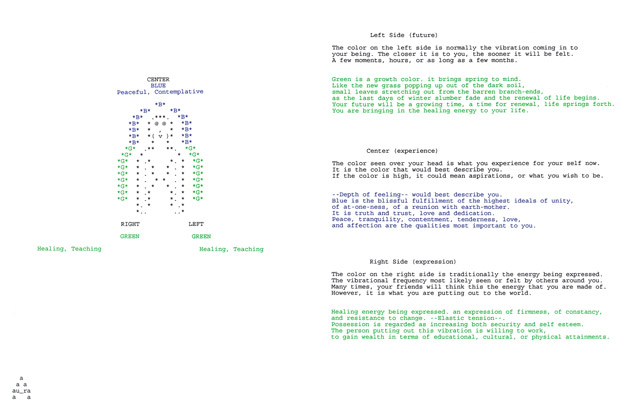

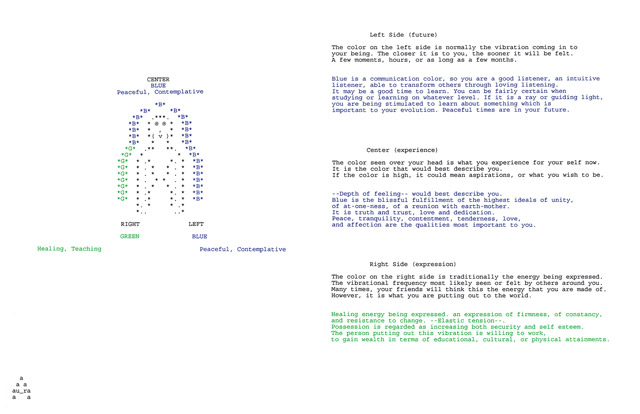

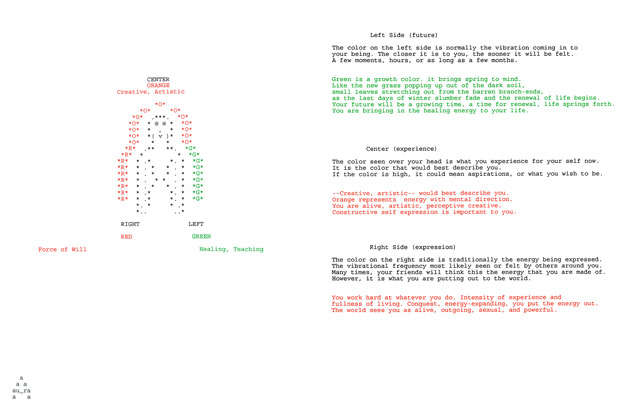
found at I heart photograph
Tuesday, March 30. 2010
Via BLDGBLOG
-----
(...)
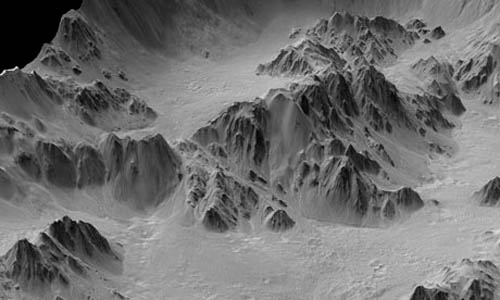 [Image: Cliffs of Mars, courtesy of NASA]. [Image: Cliffs of Mars, courtesy of NASA].
—Speaking of Mars, "the new Mars pictures are a confrontation with the sublime," Sam Leith opines in the Guardian. "Look at these photographs of Mars, and you often can't tell if you're looking at miles, or metres, or microns. It's a scale with nothing human to anchor it. It suggests an unsettling kinship between the alienness of both the very tiny and the very large."
(...)
Wednesday, July 08. 2009
Nominated by the TerraPass. team
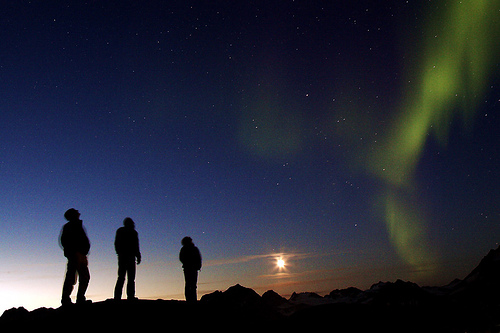 Our experiences shape our consciousness: who we are, who we become, the choices we make about how we spend our lives. But our range of experiences — from drinking from a clean, clear Sierra stream to beholding a star-filled night sky — is diminishing. With the disappearance of unmediated experiences in nature, the opportunity to know what it means to be human in the world is compromised and our awareness of the fundamental truth of the interdependent and interconnnected nature of our existence becomes more and more attenuated. This obscured perception has personal, social and global consequences. Our experiences shape our consciousness: who we are, who we become, the choices we make about how we spend our lives. But our range of experiences — from drinking from a clean, clear Sierra stream to beholding a star-filled night sky — is diminishing. With the disappearance of unmediated experiences in nature, the opportunity to know what it means to be human in the world is compromised and our awareness of the fundamental truth of the interdependent and interconnnected nature of our existence becomes more and more attenuated. This obscured perception has personal, social and global consequences.
Through all manner of artistic expression — painting, video, music, sculpture, etc, the collaborative installation, A Catalog of Extinct Experience, will evoke the experience of that connected whole. We will engage all of the senses to awaken people to the wonder of experiences gone and threatened, and the import of such loss. Our aim is neither nostalgia nor despondency, but rather to inspire awareness, wonder and gratitude for our remarkable world and to spark the recognition that our own best, creative, evolving selves grow out of and depend on preserving a diverse and evolving planet.
The website for the project is expanding and under development.
Chris Desser, the creator and founder of the project, has done at lot of work at the intersection of the environment, politics, and technology. She can be reached at cdesser@mac.com.
This piece is part of Worldchanging's Attention Philanthropy campaign. All week long, the Worldchanging Network will be delivering "attention grants" to worthy projects, individuals, resources and more. You can learn more about these gifts of notice and find other entries by clicking here.
Photo credit: Flickr/Nick Russill, Creative Commons License.
-----
Via WorldChanging
Personal comment:
Une approche et un texte peut-être un peu "conservateur" et nostalgique: quelles nouvelles expériences ont été gagnées et quelle nouvelle définition trouver de "la nature" aujourd'hui alors qu'elle est "artificielle" ou partiellement déformée/manufacturée par l'activité humaine. Si l'on s'en tient à l'ancienne acceptation du mot nature, alors la nature n'existe plus. Reste que la perte des expériences ou d'un "spectre d'expériences" large est une véritable question, à mettre en parallèle avec le "devenir confortable" de notre environnement quotidien.
Thursday, July 02. 2009
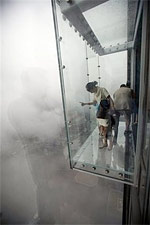 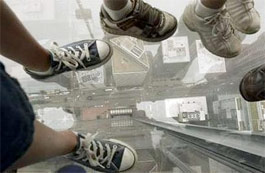
Sears Tower unveils glass balconies. Acrophobia and vertigo included. Lets look.
-----
Via Archinect
Thursday, June 18. 2009
What if our buildings could harvest power from the air, not wind or solar but literally out of thin air? Its not as crazy as it first sounds with cities literally spewing out electromagnetic radiation from TV, Radio, and Mobile phones constantly. That’s just what Nokia is doing right now, actively researching this for future generations of Mobile phones.
It’s also not a new idea, in fact the first station to harvest the power from the atmosphere has already been built and now stands derelict in a plot on Long Island for sale for $1.6 million. (map)
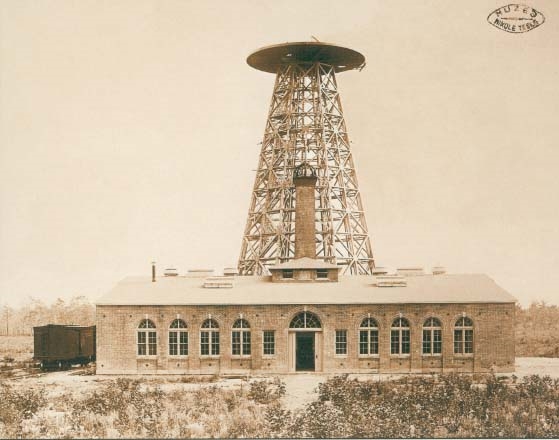
The tower was conceived by Nicola Tesla to transmit information and power. It was even speculated that Tesla intended for the tower to demonstrate how the Ionosphere could be used to provide free electricity to everyone without the need for power lines. The First transmission tower, Wardenclyffe Tower was actually built, work started in 1901:
In 1901, Nikola Tesla began work on a global system of giant towers meant to relay through the air not only news, stock reports and even pictures but also, unbeknown to investors such as J. Pierpont Morgan, free electricity for one and all….The first tower rose on rural Long Island and, by 1903, stood more than 18 stories tall. One midsummer night, it emitted a dull rumble and proceeded to hurl bolts of electricity into the sky. (via)
Tesla Tower or Wardenclyffe Tower building was designed by infamous NY Architect Stanford White who was later shot at Madison Square Roof Garden by the jealous husband of one of his lovers . (See the excellent book on White called The Architect of Desire us/uk). However the project soon ran into financial problems and when Marconi sent a radio transmission across the Atlantic on the 12th Dec 1901, it helped to scupper Tesla’s much more ambitious project. Tesla quickly tried to change the purpose of the Tower to a power generator and transmitter taking power from the ionosphere, but time and money ran out for him and he eventually had to sell the station to pay his debts. Now the site is derelict and for sale and campaign has started to save the building.

Image from NYT article
So the idea is not new but perhaps more powerful than ever. If we can suck in energy from the air around us for mobile phones then why not by buildings? Whether it would be mega projects of huge pylon towers sucking in power from the city around or more ambiently from integrated receptors on the roofs of housing blocks powering heating systems locally, the idea really seductive.
References:
Nokia want to build phones that will recharge this way.
NYT has an excellent article about Tesla and Wardenclyffe.
The Tesla Memorial Society of New York & The Telsa Wardenclyffe Project
-----
Via Lewism
Personal comment:
On a déjà blogué sur le sujet, intéressant de constater que l'idée continue à faire son chemin!
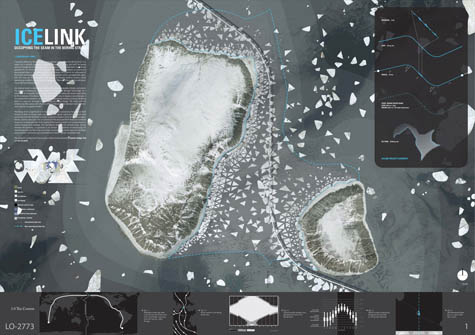 [Image: From "IceLink: Occupying the Temporal Seam" by Lateral Architecture]. [Image: From "IceLink: Occupying the Temporal Seam" by Lateral Architecture].
In their submission to the recent competition to design a bridge across the Bering Strait – the Bering Strait Connection – Toronto's Lateral Architecture proposed "IceLink: Occupying the Temporal Seam."
Lateral Architecture, of course, are also the brains behind the excellent blog InfraNet Lab, as well as the designers of both the Air Unit and the awesome Runways to Greenways plan proposed for Iceland – and IceLink is no less interesting than either of those.
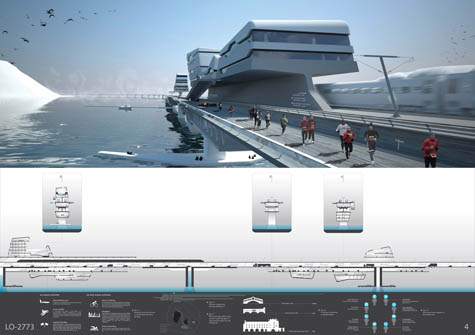 [Image: From IceLink by Lateral Architecture]. [Image: From IceLink by Lateral Architecture].
First, for those of you who did not see the original call for projects, the Bering Strait Connection described itself as a "project attempting to connect two continents":
In a wide sense, it includes building a tunnel or a bridge at both ends of the strait, extending [the] existing railways of the United States and Russia, and laying a world highway around the coasts of the world, which requires a massive amount of construction.
Architects were asked to design "a peace park with a bridging structure using the two islands, Big Diomede and Little Diomede at the Bering Strait," and a "proposal of how to connect two continents."
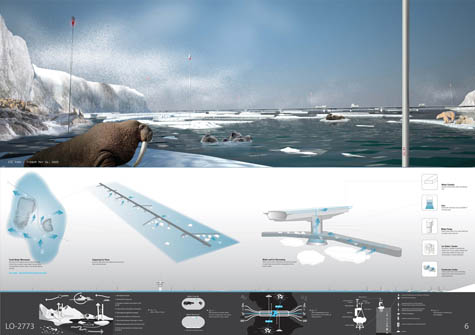 [Image: From IceLink by Lateral Architecture]. [Image: From IceLink by Lateral Architecture].
In response to this, then, Lateral proposed: "1) a tunnel/bridge hybrid that runs along the international date line and accumulates diplomatic programs, and 2) a seasonal ice park that harvests ice floes into a global water vault."
A global water vault: it's ideas like this that make me love architecture.
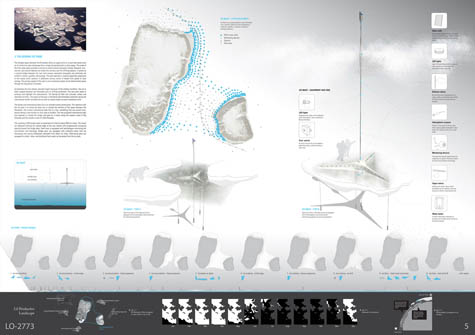 [Image: From IceLink by Lateral Architecture]. [Image: From IceLink by Lateral Architecture].
So the site, of course, would straddle two very different timezones: that is, both today and tomorrow (or today and yesterday). If I wasn't living in a temporary apartment right now, and thus without access to my books, I would quote from Umberto Eco's intellectually pessimistic novel The Island of the Day Before. There, we read how a shipwrecked scientist repeatedly fails to come to grips with the temporal (and epistemological) fact of his maritime abandonment along the international date line.
But, perhaps to the benefit of my readers, I can't.
Instead, let me also mention The Cryptographer, a novel by Tobias Hill. While it would be hard actually to recommend the book, it's nonetheless worth mentioning Hill's use of the international date line as an origin point for a currency-destroying computer virus: the Date Line Virus. Hill's Date Line Virus spreads westward with the ticking of the clock – or the turning of the earth – erasing digital savings and scrambling all systems of measured economic value.
That is, the world's entirely computer-based monetary system, hour by hour, goes mad.
Clearly, then, from even only these two examples, the narrative possibilities – and intellectual stakes – of the international date line are fairly interesting to draw on. Or, for instance, check out this factoid, from that well-known source of scientific accuracy, Wikipedia:
For two hours every day, at UTC 10:00–11:59, there are actually three different days observed at the same time. At UTC time Thursday 10:15, for example, it is Wednesday 23:15 in Samoa, which is eleven hours behind UTC, and it is Friday 00:15 in Kiritimati (separated from Samoa by the IDL), which is fourteen hours ahead of UTC. For the first hour (UTC 10:00–10:59), this phenomenon affects inhabited territories, whereas during the second hour (UTC 11:00–11:59) it only affects an uninhabited maritime time zone twelve hours behind UTC.
For two hours, in other words, there are three different days happening on the earth simultaneously.
But what about the spatial possibilities of the international date line?
How can this strange temporal fissure in the planet's political and cultural landscape be taken advantage of architecturally?
 [Image: From IceLink by Lateral Architecture]. [Image: From IceLink by Lateral Architecture].
IceLink, its designers write, without much surprise, "seeks to capitalize and highlight [the Strait's] unique geography, climate, and context." However, they add, "The intent here is less to impose a new landscape in this context than to emphasize the sublime conditions already existing. Currently, the Bering Strait is a seasonal barometer of the impacts of climate change. The intent with this scheme is to offer spaces with which to reflect on the correlation between natural environments and their occupation."
This is where we come to the project's "two primary infrastructural elements: a tunnel-bridge link and an ice park."
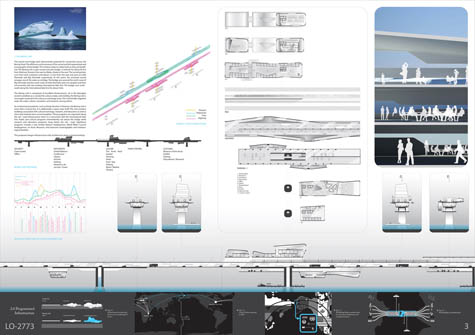 [Image: From IceLink by Lateral Architecture]. [Image: From IceLink by Lateral Architecture].
The so-called "Bering Link" half of the project would consist of "bundled infrastructures," the architects explain; these infrastructures would span a distance of 85km, from Dezhnev, Russia, to Wales, Alaska. In the process, the Bering Link would skirt the Diomede islands, and even travel north-south atop the date line for 4km.
Alongside this would be a series of new buildings, "concurrent with the international date line."
Public and cultural programs intermittently rise above the bridge while research and education programs hang below the rail/road. Significant programs include a new United Nations headquarters, World Water Council headquarters, an Arctic Museum, and extensive oceanographic and meteorological facilities.
It's a little hard to believe that the United Nations would move its headquarters to the middle of the Bering Strait – after all, thriller-reading Christians know that they'll soon be moving it to Baghdad – but it's a pretty ingenious move to put the World Water Council headquarters out there.
Why?
Here we come to the second half of Lateral's project: the "Bering Ice Park," a kind of floating archive and index of global climate change:
Sea ice is often trapped between the Diomedes prior to drifting northward. The new park seeks to enhance and highlight this phenomenon. The Bering Ice Park will cultivate, collect and distribute ice floes. The extent of the park is defined by the Diomedes coastlines facing the international border and date line as well as natural ocean currents movement north.
I'm reminded of BLDGBLOG's earlier look this month at the terroir of drinking water, in a guest post by Nicola Twilley: might specially cultivated Date Line Water™ from Lateral's Bering Ice Park someday arrive on the tables of high-end restaurants the world over?
As it happens: no. The project described here did not manage to find a place amongst the finalists of the design competition.
To see what did make the cut, take a look at the results over at Bustler.
(Lateral Architecture's Air Unit makes a brief appearance in The BLDGBLOG Book – so if you haven't yet picked up a copy, be sure to do so soon!)
-----
Via BLDBLOG
Personal comment:
Une architecture construite dans le détroit de Béring, sur la ligne de séparation temporelle et qui vit donc à la fois aujourd'hui et hier... intéressant.
Wednesday, June 17. 2009
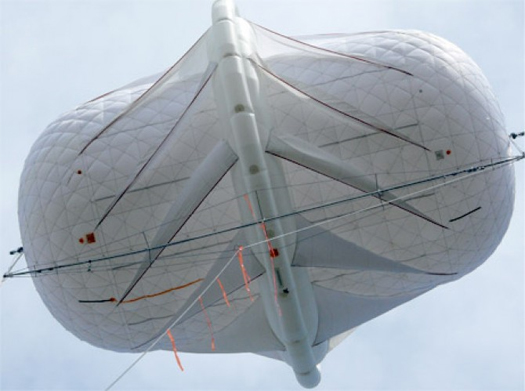
Wired comments on a topic — high-altitude wind power — that mammoth explored a couple years ago while developing a competition entry:
The wind blowing through the streets of Manhattan couldn’t power the city, but wind machines placed thousands of feet above the city theoretically could.
The first rigorous, worldwide study of high-altitude wind power estimates that there is enough wind energy at altitudes of about 1,600 to 40,000 feet to meet global electricity demand a hundred times over.
The very best ground-based wind sites have a wind-power density of less than 1 kilowatt per square meter of area swept. Up near the jet stream above New York, the wind power density can reach 16 kilowatts per square meter. The air up there is a vast potential reservoir of energy, if its intermittency can be overcome.
Even better, the best high-altitude wind-power resources match up with highly populated areas including North America’s Eastern Seaboard and China’s coastline.
“The resource is really, really phenomenal,” said Christine Archer of Cal State University-Chico, who co-authored a paper on the work published in the open-access journal Energies. ”There is a lot of energy up there, but it’s not as steady as we thought. It’s not going to be the silver bullet that will solve all of our energy problems, but it will have a role.”
…
During the energy shocks of the 1970s, when new energy ideas of all kinds were bursting forth, engineers and schemers patented several designs for harnessing wind thousands of feet in the air.
The two main design frameworks they came up with are still with us today. The first is essentially a power plant in the sky, generating electricity aloft and sending it down to Earth via a conductive tether. The second is more like a kite, transmitting mechanical energy to the ground, where generators turn it into electricity.
We thought that it would be fantastic to coat the sky above the city with thousands of these shimmering kites, the massed arrays glittering on sunny days and hidden — but for the long stalks of their slender tethers — above cloudy banks on others. As their tethers furl and unfurl to hold the kites’ positions in the windy altitudes, the kites would form a fluctuating map of the vectors and velocities unfolding above the city, perhaps also pierced by and hence revealing the aerial roads traced by the flight paths of jetliners and corporate helicopters. It might even be possible to program the surfaces of the kites, whether by adjusting the angle of the kites and altering reflection patterns or through some malleable and colored surface treatment, to serve as a massive, one-to-one diagram of the energy use patterns of the city. Like Positive Energy’s neighborhood report cards, but at an immense scale.
-----
Via Mammoth
Personal comment:
Toutes ces propositions pour capturer (une partie de) l'énergie présente sur Terre sont fascinantes. Elles fonctionnent toutes à l'échelle globale, considérant la Terre comme un système et confirmant d'une certaine façon une pensée à échelle mondiale.
Un élément, toutefois, me semble manquer à toutes ces réflexions et dont le manque est finalement assez inquiétant: si on retire de l'énergie au "système Terre" pour allumer nos ampoules et chauffer nos maisons, qu'advient-il alors de l'équilibre du système!?
A partir du moment au l'architecture, les villes et tous nos artefacts deviennent parties prenantes d'un éco-système global, ne devrait-on pas alors penser ces parties comme inter-dépendantes (une ville consomme autant d'énergie que x orages et éclairs, x ouragans ou x forêts peuvent en produire)? De la même façon qu'on n'introduit plus aujourd'hui naïvement n'importe quel animal dans n'importe quel éco-système de peur de le déstabiliser, une architecture / un urbanisme "éco-durable" peuvent eux aussi certainement déstabiliser un éco-système à partir du moment où ils en sont co-dépendants...
Ce serait ici évidemment intéressant d'avoir l'avis d'un spécialiste, peut-être que l'énergie capturée représente une part infininiment petite de l'énergie terrestre, n'affectant ainsi en rien le système dans son ensemble (hypothèse fort probable d'ailleurs). Cela est probablement toutefois plus discutable dans le contexte d'éco-systèmes à plus petites échelles (par exemple capturer l'eau de pluie sur les toits des maisons d'une petite ville et l'insérer dans un circuit interne avant de relacher ce qu'il reste dans la nature --comme dans cet exemple--, pourrait transformer l'écologie d'un lieu (assèchement des nappes phréatiques, de petis cours d'eau, etc.).
|



 It seems that time travel has captured the imaginations of people since time began. Einstein’s Special Theory of Relativity speculated that traveling close to the speed of light would physically alter time by dilating it. This means that there should be places where time slows down, and others where time speeds up.
It seems that time travel has captured the imaginations of people since time began. Einstein’s Special Theory of Relativity speculated that traveling close to the speed of light would physically alter time by dilating it. This means that there should be places where time slows down, and others where time speeds up. 






 [Image: Cliffs of Mars, courtesy of NASA].
[Image: Cliffs of Mars, courtesy of NASA]. Our experiences shape our consciousness: who we are, who we become, the choices we make about how we spend our lives. But our range of experiences — from drinking from a clean, clear Sierra stream to beholding a star-filled night sky — is diminishing. With the disappearance of unmediated experiences in nature, the opportunity to know what it means to be human in the world is compromised and our awareness of the fundamental truth of the interdependent and interconnnected nature of our existence becomes more and more attenuated. This obscured perception has personal, social and global consequences.
Our experiences shape our consciousness: who we are, who we become, the choices we make about how we spend our lives. But our range of experiences — from drinking from a clean, clear Sierra stream to beholding a star-filled night sky — is diminishing. With the disappearance of unmediated experiences in nature, the opportunity to know what it means to be human in the world is compromised and our awareness of the fundamental truth of the interdependent and interconnnected nature of our existence becomes more and more attenuated. This obscured perception has personal, social and global consequences.

 [Image: From "IceLink: Occupying the Temporal Seam" by
[Image: From "IceLink: Occupying the Temporal Seam" by  [Image: From IceLink by
[Image: From IceLink by  [Image: From IceLink by
[Image: From IceLink by  [Image: From IceLink by
[Image: From IceLink by  [Image: From IceLink by
[Image: From IceLink by  [Image: From IceLink by
[Image: From IceLink by 
